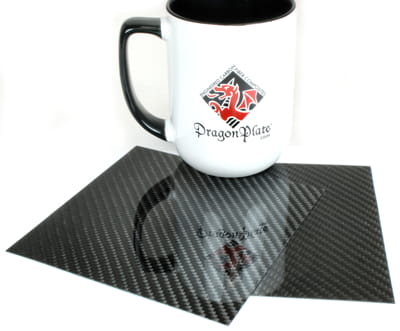Important Things to Look for When Researching Carbon Fiber Sheets
 Carbon fiber sheets have many uses, from making lightweight fixtures and robotic end of arm tooling (EOAT), to inspection fixtures that are dimensionally stable with temperature variations, to UAV components and much more. With such a wide variety of ways that one can use carbon fiber sheets, it is important to understand what to look for when researching their purchase.
Carbon fiber sheets have many uses, from making lightweight fixtures and robotic end of arm tooling (EOAT), to inspection fixtures that are dimensionally stable with temperature variations, to UAV components and much more. With such a wide variety of ways that one can use carbon fiber sheets, it is important to understand what to look for when researching their purchase.
Carbon Fiber Sheet Weaves
Carbon fiber sheets are typically made from carbon fiber cloth woven in a few basic patterns:
- Plain weave: This is the standard 1x1 over/under weave pattern. Because the yarns interlace more in a plain weave, the weave is more stable and easier to handle than a twill weave. A plain weave laminate will not be quite as strong as the tighter packed laminate of a twill weave, which will also conforms more easily to the complex curves of some tooling.
- Twill weave: Typically available in 2x2 or 4x4 over/under weave patterns, the twill weave offers a more modern look and is the design most people visualize when they think of carbon fiber products. In a 2x2 weave, each tow passes over two tows and then under two tows, while a 4x4 weave, each tow passes over four tows and then under four tows. Because the weave pattern is staggered, a diagonal appearance is created. There are fewer stress points in a twill weave than in a plain weave; but twill weave carbon fiber cloth must be handled more carefully when fabricating carbon fiber sheets to avoid creating distortions in the weave.
- Harness satin weave: In a satin weave, the fill yarn passes over several warp yarns before passing under one warp yarn. A common satin weave is: 4-harness satin weave (4HS), also called crowfoot satin, in which the fill yarn passes over three warp yarns and under one warp yarn. Satin weaves are more pliable than plain or twill weave and form around complex contours easily, but offer less stability against weave distortion.
- Honeycomb weave: In a honeycomb weave, the carbon fiber is woven into a honeycomb pattern that works great as a cosmetic covering for large surfaces and makes a beautiful, decorative trim. It is less effective in structural applications due to significant variations in localized thickness and strength due to the cosmetic weave pattern.
When selecting a weave for a carbon fiber sheet, you should take into account strength, cosmetics, and any other requirements. Different weaves distribute directional forces differently, and laminate strength can vary based on layup and molding conditions. The looser a weave, the more likely gaps will occur between fibers when the woven carbon fiber is molded around complex curves. On the other hand, looser weaves make it easier to drape the carbon weave around those same complex curves. Therefore, it's important to keep your goals and requirements in mind, and work with a reputable manufacturer who can guide you through this decision making process.
Carbon Fiber Sheet Laminates
Carbon fiber sheets come in different thicknesses.. Basic levels of thickness include:
- Veneers: Typically bonded to another material, veneers are used mostly used for appearance. When researching carbon fiber veneer sheets, you want to look for the most beautiful finish that clearly shows the fibers and texture of the carbon.
- Solid: Solid carbon fiber sheets and plates are more often used for their strength and stiffness. Incorporating multiple layers of laminations to achieve this strength. Different layup orientations are used, including orthotropic (0°/90° twill weave orientation), quasi-isotropic (0°/90°/45° twill weave orientation). They can be fabricated from dry carbon fiber and resin, or from prepreg which is typically cured under temperature and pressure.
- Sandwich sheets: Carbon fiber sandwich sheets with cores made from various core materials are an excellent way to produce an exceptionally strong yet lightweight product. They also typically offer excellent sound and thermal insulation.
Because there are many carbon fiber sheets of varying quality available on the market, it is always important to carefully select the best sheet and ensure you are using the highest quality carbon fiber for your project. It is best to work with a manufacturer who understands the intricacies of weaves, fiber orientations, and sheet thickness to help you select the best product, and to avoid inexpensive imported sheets of questionable quality. Once again, it is easy to see that when working with carbon fiber products, a little research beforehand will save you time and money in the long run.